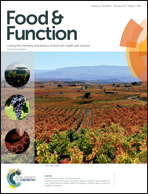Mixing behaviour of WPI–pectin-complexes in meat dispersions: impact of biopolymer ratios
Abstract
Particulated complexes composed of oppositely charged biopolymers were incorporated into highly concentrated protein matrices as potential fat replacers and structuring agents. A multistep procedure was therefore utilized to generate process-stable complexes, which were subsequently embedded into emulsion-type sausages, whereas macro- and microstructural properties were then assessed. Firstly, stock WPI and sugar beet pectin solutions were mixed under neutral conditions (pH 7) at various biopolymer ratios r (2 : 1, 5 : 1, 8 : 1). Secondly, the pH of the biopolymer mixture was decreased to 3.5 to promote associative complexation. Thirdly, electrostatically attracted biopolymer particles were subjected to a heat treatment (ϑ = 85 °C, 20 min) to enhance their stability against superimposed stresses. Finally, fat-reduced emulsion-type sausages were fabricated containing stable WPI–pectin complexes. The results revealed that the heat treatment increased the pH-stability of the biopolymer complexes. In addition, textural and sensorial analysis demonstrated that the meat products became increasingly soft as the biopolymer ratio r increased. This effect was attributed to thermodynamic incompatibility between meat proteins and beet pectin. The results obtained from this study might have important implications for the fabrication of processed meat products with reduced fat levels.



 Please wait while we load your content...
Please wait while we load your content...